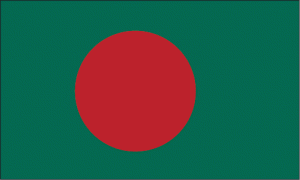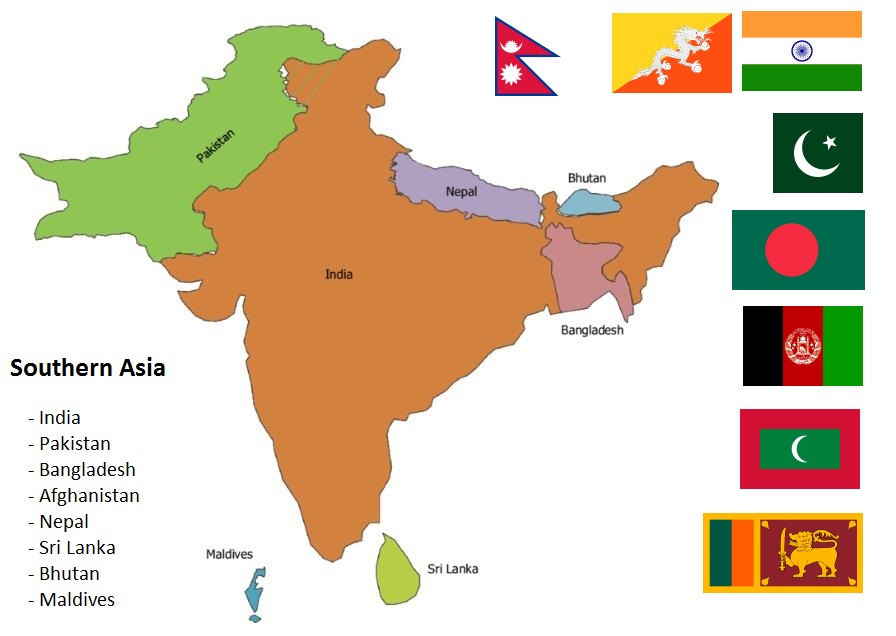Countries in Southern Asia
Located in the south of the Asian continent, South Asia is also known in other classifications as the Indian subcontinent, so it is clear that one of the countries that make up this region is India, the second most populous country in Asia, and the world as well. Other countries present in this region are: Maldives, Pakistan, Nepal, among others. One of the main characteristics of South Asia is that it is one of the poorest regions on the Asian continent. The population faces problems, such as high infant mortality, low life expectancy and little development.
How Many Countries in Southern Asia
South Asia is one of the largest and most populous subcontinents on the planet. Covering the official territory of more than 5 million km², Southern Asia is composed of 8 independent countries (Afghanistan, Bangladesh, Bhutan, India, Maldives, Nepal, Pakistan, and Sri Lanka). See below for the full list of Southern Asian Countries by population.
1. Bangladesh
Bangladesh is a republic in South Asia on the Bay of Bengal. Bangladesh is the world’s eighth most populous country and ninety – third largest country by area, making Bangladesh one of the most densely populated countries in the world. The majority of the population are Bengali Muslims, followed by Bengali Hindus, with various Buddhist and Christian communities. The official language is Bengali.
 |
|
2. Bhutan
Bhutan is a kingdom in southern Asia that borders China to the north and India to the south. The country became independent from India in 1949 and a total of about 750,000 people live in Bhutan.
 |
|
3. India
India, officially the Republic of India, is a Federal Republic of South Asia. It is the seventh largest country on the surface, the second most populous country and the most populous democracy in the world. India is often called “the world’s largest democracy”.
 |
|
4. Maldives
The Maldives, formally the Republic of the Maldives, is an island nation in the northern Indian Ocean consisting of 26 atolls with 1,192 islands of which 200 are inhabited, together populated by about 300,000 residents.
 |
|
5. Nepal
Nepal, formally the Federal Republic of Nepal, is a republic on the southern slope of the Himalayas between China in the north and India in the east, west and south.
 |
|
6. Pakistan
Pakistan, formally the Islamic Republic of Pakistan, is a country in Asia. The country is usually located in different geographical sub-areas depending on the context, such as the changing Middle East, the Middle East, South Asia, Southwest Asia and West Asia.
 |
|
7. Sri Lanka
Sri Lanka, formally the Democratic Socialist Republic of Sri Lanka, is an island nation in South Asia, located southeast of India. Sri Lanka has around twenty million residents and consists of a large tropical island and a number of small islands. Sri Lanka is a member of the Commonwealth.
 |
|
8. Afghanistan
Afghanistan is a country in southern Asia and is usually included in Central Asia. The country is mountainous and lacks a coast and borders Pakistan, Iran, Turkmenistan, Uzbekistan, Tajikistan and China. Kabul is the capital of Afghanistan.
 |
|
List of Countries in Southern Asia and Their Capitals
As noted above, there are eight independent countries in the South Asia. Among them, the largest country is India and the smallest is Maldives in term of population. The full list of Southern Asia countries with capitals is shown in the table below, ranked by latest total population and area.
| Rank | Country Name | Population | Land Area (km²) | Capital |
| 1 | India | 1,348,670,000 | 2,973,190 | New Delhi |
| 2 | Pakistan | 205,051,000 | 881,912 | Islamabad |
| 3 | Bangladesh | 166,752,000 | 130,168 | Dhaka |
| 4 | Afghanistan | 32,225,560 | 652,230 | Kabul |
| 5 | Nepal | 29,609,623 | 143,351 | Kathmandu |
| 6 | Sri Lanka | 21,670,112 | 62,732 | Colombo, Sri Jayewardenepura Kotte |
| 7 | Bhutan | 741,672 | 38,394 | Thimphu |
| 8 | Maldives | 378,114 | 298 | Male |
Map of Southern Asian Countries

Brief History of Southern Asia
Ancient Civilizations and Early Empires
1. Indus Valley Civilization:
Southern Asia is home to one of the world’s oldest civilizations, the Indus Valley Civilization, which flourished around 3300 BCE to 1300 BCE. Centered in present-day Pakistan and northwest India, the civilization boasted advanced urban planning, sophisticated drainage systems, and trade networks with Mesopotamia and Egypt. Major sites like Mohenjo-Daro and Harappa reveal insights into the culture and lifestyle of this ancient civilization.
2. Vedic Period and Early Empires:
Following the decline of the Indus Valley Civilization, the Indo-Aryans migrated into the Indian subcontinent, bringing with them the Vedas and the caste system. The Vedic period (c. 1500 BCE – 500 BCE) laid the foundation for Hinduism and the emergence of early kingdoms and republics. The Maurya Empire, under Chandragupta Maurya and his grandson Ashoka, unified much of the Indian subcontinent in the 3rd century BCE, promoting Buddhism and implementing administrative reforms.
Golden Age of Indian Civilization
1. Gupta Empire:
The Gupta Empire (c. 4th to 6th centuries CE) is often regarded as a golden age of Indian civilization, characterized by flourishing art, literature, science, and philosophy. Under rulers like Chandragupta II and Samudragupta, the empire achieved remarkable cultural and intellectual achievements, including the creation of iconic temples, the development of the decimal system and concept of zero in mathematics, and the compilation of Sanskrit literature.
2. Spread of Buddhism and Hinduism:
During this period, Buddhism spread across Southern Asia and beyond, facilitated by missionary activities and trade networks. The construction of Buddhist stupas and monastic universities, such as Nalanda and Vikramashila, contributed to the dissemination of Buddhist teachings. Hinduism also experienced significant developments, with the emergence of bhakti (devotional) movements and the codification of Hindu law in texts like the Manusmriti.
Islamic Conquests and the Delhi Sultanate
1. Islamic Invasions:
In the 8th century CE, Islamic armies from the Arabian Peninsula began invading Southern Asia, gradually establishing Muslim rule in parts of the Indian subcontinent. The Delhi Sultanate, founded by Qutb-ud-din Aibak in 1206, became the first major Islamic state in the region. Subsequent rulers, such as Alauddin Khilji and Muhammad bin Tughlaq, expanded the sultanate’s territory and implemented administrative and military reforms.
2. Mughal Empire:
In the 16th century, the Mughal Empire emerged as a dominant power in Southern Asia under the leadership of Babur, a descendant of Timur and Genghis Khan. The Mughals, who were of Central Asian Turkic-Mongol descent, established a vast and culturally diverse empire that encompassed most of the Indian subcontinent. Akbar the Great, Jahangir, Shah Jahan, and Aurangzeb were notable Mughal rulers who left a lasting impact on art, architecture, and governance.
Colonialism and Independence Movements
1. European Colonialism:
During the Age of Exploration, European powers, notably Portugal, the Netherlands, Britain, and France, established trading outposts and colonies in Southern Asia. The British East India Company gradually expanded its control over Indian territories, exploiting resources and implementing colonial policies that led to economic exploitation and social upheaval. The Portuguese controlled territories like Goa, the Dutch established trading posts in Indonesia, and the French colonized parts of India, Vietnam, and Laos.
2. Independence Struggles:
The 20th century witnessed the rise of nationalist movements across Southern Asia, seeking to end colonial rule and achieve independence. Leaders like Mahatma Gandhi in India, Muhammad Ali Jinnah in Pakistan, and Sukarno in Indonesia mobilized mass movements and resistance against colonial powers. The partition of British India in 1947 resulted in the creation of India and Pakistan, followed by subsequent independence movements in countries like Sri Lanka and Myanmar.
Modern Nation-States and Regional Dynamics
1. Formation of Nation-States:
Following independence, Southern Asia underwent a period of nation-building and political transition, with newly formed states grappling with issues of governance, identity, and socio-economic development. India emerged as the world’s largest democracy, while Pakistan struggled with political instability and ethnic tensions. Other countries in the region, such as Bangladesh, Sri Lanka, and Nepal, also faced challenges in consolidating statehood and promoting inclusive development.
2. Regional Dynamics:
Southern Asia remains a region of diverse cultures, languages, and religions, with complex geopolitical dynamics and ongoing conflicts. Tensions between India and Pakistan over the disputed region of Kashmir, ethnic and religious strife in countries like Sri Lanka and Myanmar, and the threat of terrorism and extremism pose significant challenges to regional stability and cooperation.













































